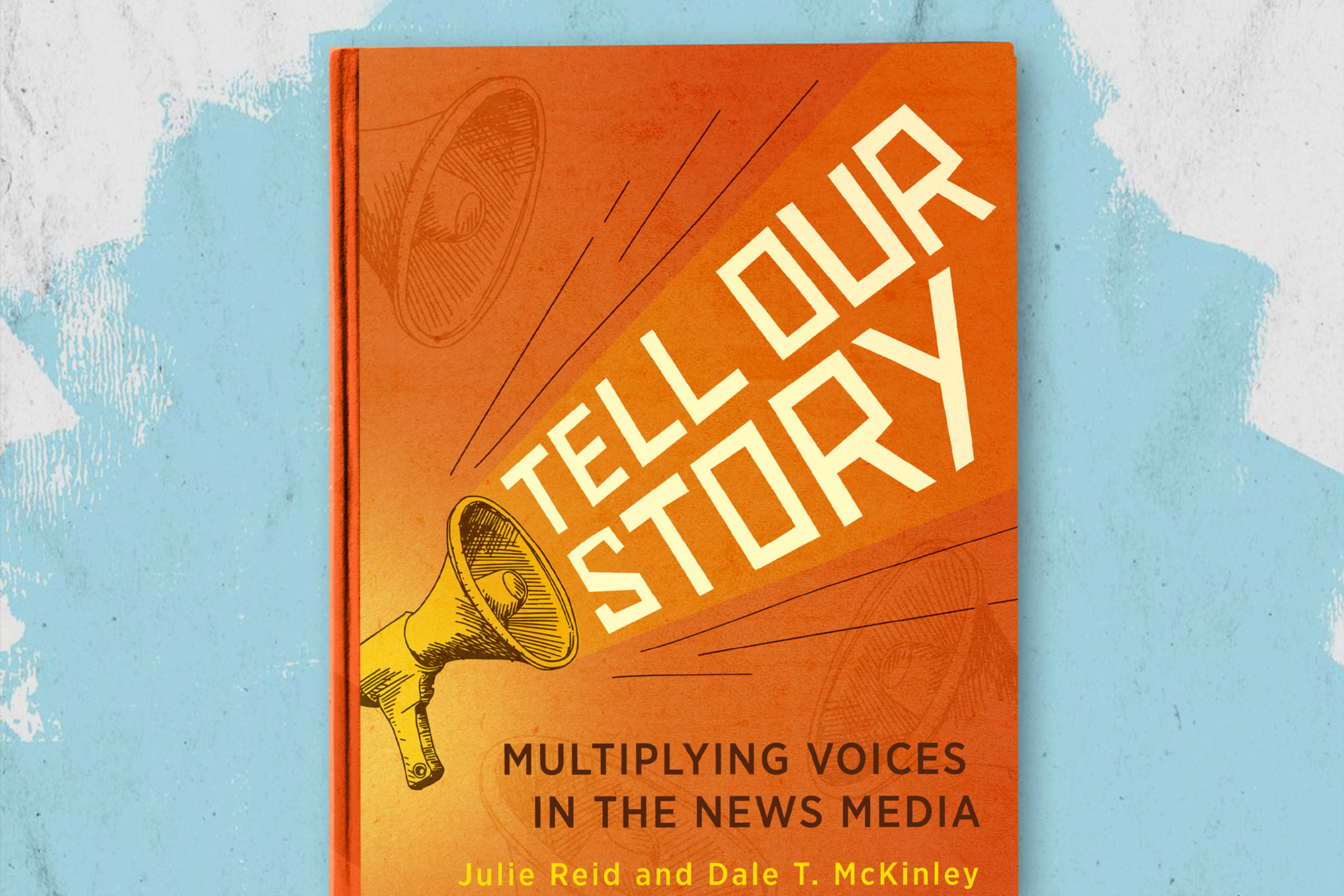New Books | Tell Our Story
While considering media freedom in South Africa, the authors ask how regulatory bodies can ensure open and fair access to news without flattening ideological positions.
Author:
8 July 2020

This is a lightly edited excerpt from Julie Reid and Dale T McKinley’s Tell Our Story: Multiplying Voices in the News Media (Wits University Press, 2020).
Media diversity and voice(s)
Published in 1960, Harper Lee’s novel To Kill a Mockingbird was immediately successful, and subsequently came to be considered one of the great classics of American literature. At the core of the book are themes of social justice and racial injustice. But it is the heart-wrenching unfairness when some people are both represented, as well as held to account, in ways that are blatantly inconsistent with other people, simply because of the power imbued in arbitrary descriptors such as race, class or social status that touches us. The mockingbird encompasses 17 different species of birds, which are known for the way in which their calls mimic other birds or insects.
In this section of this book, the mockingbird metaphor refers to dominant news media outlets that consistently mimic and reproduce content aligned to the same worldviews and ideological positioning, often at the expense of the ethical, moral and social justice implications of doing so. While the task to transform the mainstream media into a sphere that is more willing and capable of operating as a platform for the wider inclusion of voice(s) is a moral, ethical and democratic project, it is also one that can positively impact on the financial bottom line of media outlets. All over the world, and in South Africa, the news media currently faces a double-edged crisis: a crisis of credibility and a crisis of financial sustainability (the latter is particularly hard felt by the print media sector). We will address the financial sustainability aspect a little later, but first the matter of credibility, which for any legitimate news media outlet is and ought to be its most prized possession.
Political and social discourse surrounding what is now called fake news is partly fed by genuine concern for the factual accuracy of the news, but also partly by moral panic, part hysteria, a large part by political actors as a means of directing attention away from their own failings and scapegoating the media, and partly because fake news in the postdigital age becomes increasingly easier to produce, replicate and disseminate. Importantly, misinformation, in one form or another, has been with us for as long as the mass communications media has formed part of our daily lives. We used to call it things like propaganda, unethical journalism, plagiarism, brown-envelope journalism or spin doctoring.
Related article:
Traditionally, democratic societies have established regulatory bodies, such as press councils or complaints commissions, to monitor errant journalism and offer a means of media accountability by sanctioning media outlets when these are found to have breached a predetermined code of ethics. The regulatory difficulties associated with the phenomenon of fake news, however, are not as easy to handle. Firstly, fake news is not simply false news, inaccurate reporting or lazy journalism, which would fall into the usual jurisdiction of ethics bodies such as press councils. Instead, it is purposefully manufactured according to a particular political imperative, often as part of a consciously constructed campaign that aims to reach a predetermined political result. The proliferation of fake news can also be overwhelming in scale when a deliberate lie is picked up by numerous blogs, or reiterated by hundreds of websites, shared and cross-posted across multiple social media platforms and consumed by thousands of media users. It is a media regulator’s nightmare.
Problematically, the knock-on effect of this is that the mainstream media inadvertently suffers a significant dent in credibility. This is not entirely fair. While some media outlets have fallen foul, and – possibly as a result of inadequate fact-checking – have reproduced fake news content, we already know that a significantly large quantity of fake news in circulation is initiated by governments or political actors, motivated by political imperatives, such as swinging elections or damaging the reputation of opponents. This is coupled with an increasing and substantial trend of conscious delegitimisation of the news media, largely caused by sustained and systematic attacks on the media by government actors.
Today, government representatives and spokespeople regularly trivialise and insult the media, sometimes characterising it as the “enemy”, in ways that would have been unthinkable just a few years ago in democratic societies, and which would have undoubtedly drawn vehement criticism with regard to the implications on the freedom of the press and media independence. But political leaders now swat critical news stories aside with relative ease, simply by referring to them as fake news. Not only does this kind of delegitimisation reinforce attacks on the media by other sections of society, but the often misguided messaging of these campaigns is heard by thousands of people, and no doubt believed by some.
As a result, the news media’s credibility suffers, which is only compounded when combined with the already legitimate grievances of large swathes of society that the media routinely offers these people no “voice”, no representivity and habitually ignores stories from the ground. Where a majority of people already harbour a bitterness towards the dominant news media for its treatment of their stories and communities, it is unlikely that such audiences would be persuaded to nonetheless retain faith in the news in the era of the fake news phenomenon. This then becomes an inconvenient toxic mix for the dominant press: audiences who did not trust the media to begin with (for reasons that can be laid squarely at the door of the mainstream media) are unlikely to treat the fake news conundrum faced by the media today with much compassion, regardless of whether the fake news phenomenon is of the mainstream news media’s making or not.
But it is also a toxic mix for participatory democracy, the effectiveness of which relies on an informed citizenry. In simple terms, it is important that people do indeed believe what they see in the news, reliant, of course, on the prerequisite that news content is fair, accurate, balanced and, well, not fake. The academic field of media diversity studies, as well as media lawmakers and regulators (in democratic countries and institutions at least), have long reached consensus that media diversity is a crucial aspect of the information landscape and vital to the health of a robust democracy. The precise nature of the notion of media diversity is widely theoretically contested.
Related article:
But leaving aside the highly complex nuts and bolts of media diversity theory, one basic normative premise prevails almost universally among researchers, media rights activists and, importantly, multilateral, international and (democratic) governmental media-orientated groupings and law-making initiatives. This means that the diversity of content in the media is important to society and democracy, and should reflect the widest possible range of cultural and political ideas, because the media is integral to each individual’s formulation of personal opinions, ideas and worldview. A diverse media landscape is one that provides each media user with access to a broad spectrum of information, political orientations and cultural practices, so that the individual is able to freely determine their own position within the political world and decide how and when to participate in that world.
The idea is simple enough: access to a variety of ideas and information is a good thing. It is also why when authoritarian regimes inhibit the spectrum of content available in a country’s media it is considered a violation of the freedoms and information rights of its citizens, as is the case in countries such as North Korea, for example, and, to some extent, China. But even in mature or developing democracies, acceptable and sustainable levels of media diversity are not always easily achieved.
The most prominent inhibitor of media diversity in democratic societies is the over-concentration and monopolisation of media markets. Thinking in business terms, as cultural artefacts, media products bear a high risk of failure. Larger media conglomerates are able to mitigate these risks: if one media product proves unpopular, such failure can be covered and financed off the profitability of more successful products. Smaller media companies and new entrants are less able to afford or withstand product failure, and face a much higher degree of risk. Resultantly, media systems are often dominated by large monopolies and an unpluralistic ownership pattern, where a small collection of media owners produce, disseminate and control the majority of media content.
What this means for the ordinary audience member is that although one might have access to a reasonable variety of programmes, channels and/or newspapers, these are all produced by the same company and therefore potentially all bear a similar ideological orientation. This is far from ideal with respect to gaining the widest possible access to a broad range of opinions and ideas. Here, the media diversity principle fails in practice.
In various countries, this has prompted lawmakers to discuss or attempt market intervention, and South Africa is not an exception. Between September 2011 and March 2012, the South African Parliamentary Portfolio Committee on Communications hosted a series of discussions on transformation and diversity within the print media sector. African National Congress (ANC) Portfolio Committee members argued in favour of the development of a print media transformation charter, which was reiterated in the party’s 53rd national conference resolutions in December 2012, then framing the notion as an “economic empowerment charter to promote Broad Based Black Economic Empowerment in the sector”. These sentiments were again echoed by the then minister of communications, Faith Muthambi, and the Universal Service and Access Agency of South Africa CEO, Lumko Mtimde (formerly the head of the Media Development and Diversity Agency), at the Print Media Transformation Colloquium in August 2016, which was organised by the Department of Communications.
Related article:
Unfortunately, the answer to this media diversity conundrum is not as simple as ensuring a plurality of media ownership. The support of new entrants and/or the breaking up of media monopolies can have a ruinous effect on the media system in its entirety. When the number of media outlets within a particular media market increases, each separate outlet then naturally captures a smaller portion of the audience. As the audience fragments across different outlets, the profitability of each outlet diminishes, meaning that less expensive and lower quality content is then offered by the outlet, which in turn reduces the outlet’s audience and income. Large parts of the media system in this scenario are then caught in a downward spiral.
The situation can be somewhat rescued by something called Hotelling’s law of excessive sameness. A greater number of media outlets within a media system results in a highly competitive market and homogeneity of content often results, where competing media outlets try to imitate the content offered by their competitors. Under conditions of such fierce competition, the social and democratic importance of providing a broad spectrum of diverse content is superseded by each media outlet’s battle to remain financially sustainable in a highly competitive environment. This situation is also detrimental to experimentation, since, again, media outlets are less able to financially withstand the risk associated with more innovative products, and rely more heavily on the tried and tested and already proven to be popular products. In other words, audiences are fed more of the same by a wider number of media outlets.
While all of this goes some way to preventing the complete ruin of the media market, and superficially preserves the financial sustainability of media outlets, it does not offer much help in providing the population of media users with access to a broad spectrum of diverse ideas, opinions and worldviews. Combating the over-concentration of a media market by encouraging the start-up of new entrants and the breaking up of monopolies can potentially result in degrees of excessive sameness that actually see audiences worse off than they were before, with regard to their mediated levels of exposure to varying opinions, ideas and views. In light of the above, and although the South African media market is somewhat concentrated in ownership structure, with the state-owned South African Broadcasting Corporation (SABC) operating as the biggest monopoly in terms of audience figures, it has to be borne in mind that an already financially strained media market as small as South Africa’s would likely struggle to withstand interventions in the market by government, however well-intentioned these may be.



